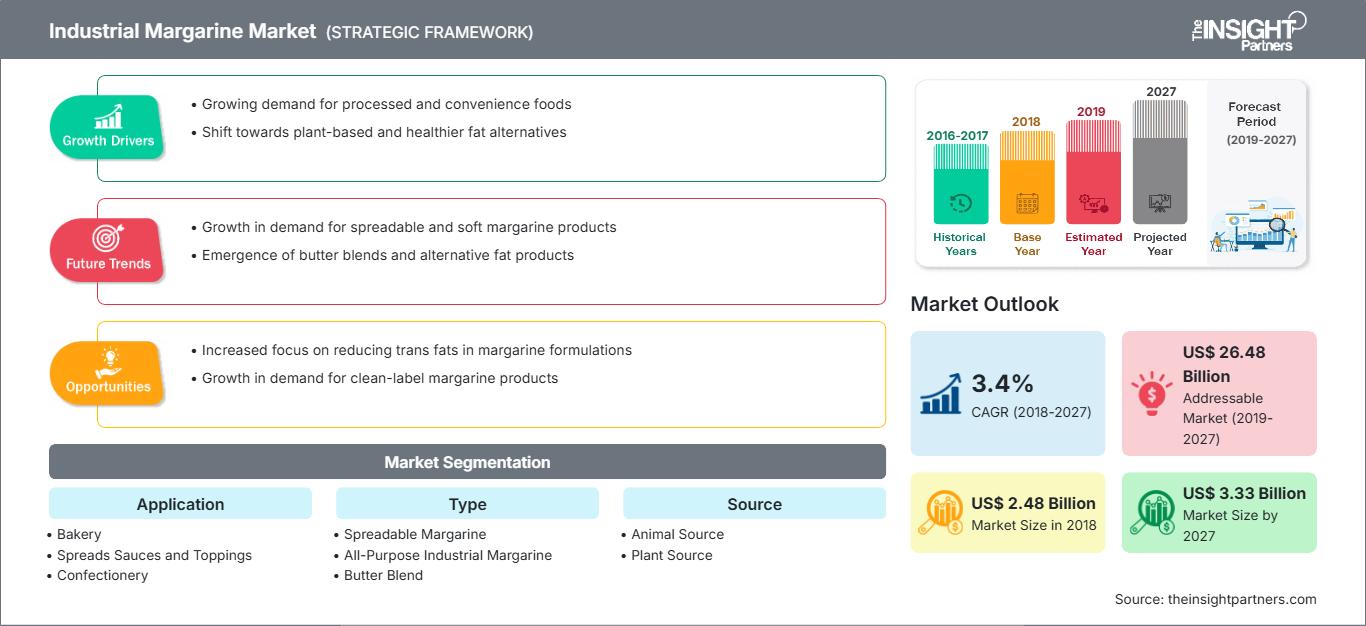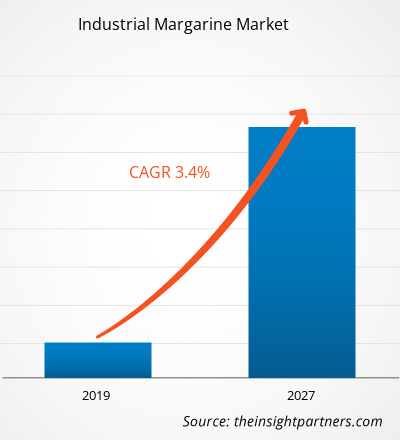[研究报告]2018 年工业人造黄油市场价值为 24.8 亿美元,预计到 2027 年将达到 33.304 亿美元;预计 2019 年至 2027 年的复合年增长率为 3.4%。
工业人造黄油是一种用作黄油替代品的乳制品。虽然工业人造黄油和黄油都用于改善各种菜肴的风味,但它们具有截然不同的特性。黄油由水、蛋白质和乳脂组成,而动物脂肪和/或加工植物油则由工业人造黄油组成。
预计北美工业人造黄油市场在预测期内的复合年增长率最高。该地区市场的增长主要归因于糖尿病、高血压和便秘等疾病的发病率上升,因为消费者的健康意识越来越强。因此,美国食品生产商正致力于生产不含反式脂肪的人造黄油产品。工业人造黄油需求的不断增长,得益于人造黄油制造商推出的众多新型改性人造黄油产品,例如低脂或无脂涂抹酱,以及添加维生素D强化牛奶的人造黄油。北美地区对工业人造黄油需求的不断增长,吸引了制造商在该地区建立业务,这进一步推动了欧洲工业人造黄油市场的增长。
自定义此报告以满足您的要求
您将免费获得任何报告的定制,包括本报告的部分内容,或国家级分析、Excel 数据包,以及为初创企业和大学提供超值优惠和折扣
工业人造黄油市场: 战略洞察

-
获取本报告的主要市场趋势。这个免费样本将包括数据分析,从市场趋势到估计和预测。
由于封锁、旅行禁令和企业停工,
COVID-19 疫情对各国经济和行业产生了不利影响。食品和饮料是遭受严重影响的重要行业之一,例如供应链受限和生产工厂停工。2019 年冠状病毒病 (COVID-19) 的全球影响已初现,2020 年的块状人造黄油需求将受到显著影响。
COVID-19 影响了消费者行为和需求、购买习惯、供应链重新规划、市场动态以及政府干预。因此,这些因素正在抑制食品和饮料行业工业人造黄油市场的增长。
市场洞察:低热量食品需求增长预计将推动工业人造黄油市场增长
随着生活方式的改变和健康意识的增强,对低脂食品和饮料的需求不断增加,工业人造黄油市场也在增长。年轻人越来越意识到均衡饮食对健康的好处,例如避免肥胖和糖尿病。超市低热量食品种类的增加,以及制造商为扩大产品范围和以低价销售优质产品而进行的大量研发工作,都将有助于市场增长。Vandemoortele、联合利华、理查森国际有限公司和康尼格拉品牌公司是工业人造黄油的主要制造商之一,他们销售低热量工业人造黄油,以吸引注重健康的年轻一代。
类型洞察
根据类型,工业人造黄油市场分为可涂抹人造黄油、通用工业人造黄油和黄油混合物。可涂抹工业人造黄油部分在 2018 年占据了更大的市场份额。与黄油相比,工业人造黄油在室温下具有更好的涂抹性。由于其比黄油更佳的涂抹性,人造黄油已成为一种更受欢迎且成本更低的餐桌涂抹酱。工业人造黄油仍然是常见的吐司和面包涂抹酱。由于其顺滑和奶油般的质地,它通常被用来替代更昂贵的黄油。人造黄油涂抹酱通常胆固醇和反式脂肪含量较低,使其成为均衡的替代品。工业人造黄油中低密度脂蛋白胆固醇(LDL-C)可能会推动市场发展,因为越来越多注重胆固醇的消费者会消费它。
因此,预计所有这些都将在预测期内推动对工业人造黄油的需求。
应用洞察
根据应用,工业人造黄油市场细分为烘焙食品、涂抹酱、酱料和配料、糖果、方便食品等。烘焙食品在 2018 年占据了最大的市场份额。羊角面包人造黄油、硬泡芙人造黄油、奶油人造黄油、蛋糕人造黄油和酥皮人造黄油是烘焙行业最受欢迎的工业人造黄油类型。人造黄油可用于制作各种烘焙食品中的小麦面团,使其更加柔软。面包师偏爱人造黄油,因为它质地柔软,易于搅拌奶油糖霜或海绵蛋糕的奶油糖霜。丹麦酥皮点心则用人造黄油卷制而成。条状人造黄油,也称为块状或粗粒人造黄油,质地类似于黄油,因此在烘焙和烹饪中用作黄油替代品。在预测期内,烘焙企业对工业人造黄油的消费量预计将增长,从而刺激对该产品的需求。工业人造黄油市场的一些参与者包括:英国联合食品公司、邦吉有限公司、康尼格拉食品服务公司、EFKO集团、富士石油欧洲公司、NMGK集团、焙乐道、理查森国际有限公司、范德莫特尔和丰益国际有限公司等。重点公司实施并购和研发战略,以扩大客户群并在全球市场上获得显著份额,这也使他们能够在全球范围内维护自己的品牌名称。
工业人造黄油市场区域洞察
The Insight Partners 的分析师已详尽阐述了预测期内影响工业人造黄油市场的区域趋势和因素。本节还讨论了北美、欧洲、亚太地区、中东和非洲以及南美和中美洲的工业人造黄油市场细分和地域分布。
工业人造黄油市场报告范围
| 报告属性 | 细节 |
|---|---|
| 市场规模 2018 | US$ 2.48 Billion |
| 市场规模 2027 | US$ 3.33 Billion |
| 全球复合年增长率 (2018 - 2027) | 3.4% |
| 历史数据 | 2016-2017 |
| 预测期 | 2019-2027 |
| 涵盖的领域 |
By 应用
|
| 覆盖地区和国家 |
北美
|
| 市场领导者和主要公司简介 |
|
工业人造黄油市场参与者密度:了解其对业务动态的影响
工业人造黄油市场正在快速增长,这得益于终端用户需求的不断增长,而这些需求的驱动因素包括消费者偏好的演变、技术进步以及对产品优势的认知度的提升。随着需求的增长,企业正在扩展产品线,不断创新以满足消费者需求,并抓住新兴趋势,从而进一步推动市场增长。

- 获取 工业人造黄油市场 主要参与者概述
- 工业人造黄油市场不断发展的行业趋势,帮助参与者制定有效的长期战略
- 发达市场和发展中市场采用的业务增长战略
- 2019 年至 2027 年工业人造黄油市场的定量分析
- 全球工业人造黄油需求估算
- PEST 分析,说明行业买家和供应商的有效性
- 了解竞争激烈的市场形势的最新发展
- 市场趋势和前景,以及推动和抑制工业人造黄油市场增长的因素
- 通过强调支撑商业利益的市场策略来协助决策过程,从而促进市场增长
- 不同节点的工业人造黄油市场规模
- 市场的详细概述和细分,以及工业人造黄油行业动态
- 各地区工业人造黄油市场规模,增长前景看好
- 烘焙
- 涂抹酱料和配料
- 糖果
- 方便食品
- 其他
工业人造黄油市场 — 按类型
- 可涂抹人造黄油
- 通用工业人造黄油
- 黄油混合物
工业人造黄油市场 — 按来源
- 动物来源
- 植物来源
工业人造黄油市场 —按表格
- 硬质工业人造黄油
- 软质工业人造黄油
公司简介
- 邦吉有限公司
- 英国联合食品有限公司
- 康尼格拉品牌公司
- EFKO 集团
- 富士石油欧洲公司
- NMGK 集团
- 焙乐道集团
- 理查森国际有限公司
- 范德莫特勒集团
- 丰益国际有限公司
- 历史分析(2 年)、基准年、预测(7 年)及复合年增长率
- PEST和SWOT分析
- 市场规模、价值/数量 - 全球、区域、国家
- 行业和竞争格局
- Excel 数据集
近期报告
客户评价
购买理由
- 明智的决策
- 了解市场动态
- 竞争分析
- 客户洞察
- 市场预测
- 风险规避
- 战略规划
- 投资论证
- 识别新兴市场
- 优化营销策略
- 提升运营效率
- 顺应监管趋势






















 获取免费样品 - 工业人造黄油市场
获取免费样品 - 工业人造黄油市场